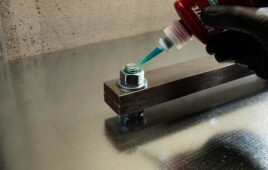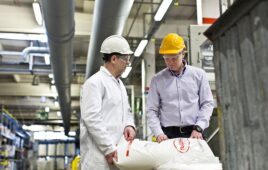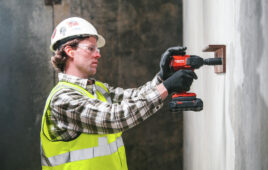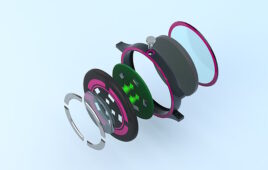By Jamie Hubbard, Market Application Engineer, Adhesives Division, Henkel Corporation
Changing requirements and regulatory restrictions can play a major role when making material decisions.
Solar module manufacturers continuously search for automated fabrication methods that will reduce production costs and time requirements. Adhesives have proven themselves to be fast and cost-effective automated assembly alternatives, reliably withstanding harsh environmental conditions over the long service life of a solar module.

An elastomeric adhesive is dispensed onto the back rail and the part is mated to the solar module for a specific duration of time to fixture the adhesive.
For photovoltaic assembly applications such as framing and mounting modules, bonding junction boxes and attaching back rails to frames, the most commonly used adhesives have traditionally included single-component room temperature vulcanizing (RTV) silicones and double-sided adhesive tapes. Neither technology is ideal for today’s fast-paced automated production environments where high-volume throughput can increase work in process (WIP) and associated parts racking while adhesives fully cure.
In response to the solar industry’s demand for faster curing adhesives that keep pace with high volume production processes, new elastomeric adhesive options have become available that successfully function as adhesives and sealants. These elastomeric technologies include silicones, silyl-modified polymers (commonly referred to as SMP or MS), and butyl polymers.
Elastomeric advantages
While many adhesive chemistries cure into high modulus, rigid materials that cannot compensate for the differential thermal expansion and contraction rates of substrates, elastomeric adhesives cure to form rubbery, flexible bonds. An elastomeric adhesive is capable of absorbing high amounts of strain at the bond line when glass and metal substrates expand and contract at different rates as a result of typical day-to-night temperature fluctuations. The adhesives exhibit very low glass transition temperatures and maintain their flexibility even at the lowest potential operating temperatures.

The most common materials used as supporting back rails are galvanized steel, aluminum, and stainless steel. Within a solar fabrication line, a two to six mm gap exists between the back rail and the module.
Elastomeric adhesives offer high peel strength, toughness and flexibility. They expand and compress, yet easily return to their original shape once stress is reduced. Many elastomeric adhesives provide exceptional adhesion to glass, aluminum, galvanized steel, and a variety of plastics and backsheet polymers, including Tedlar®. Elastomeric adhesives are exceptional for uniformly filling large gaps between substrates.
These adhesive technologies resist weathering, moisture and sunlight, yet exhibit fast handling strength. While one-part elastomeric adhesives have historically taken between four and 12 hours to reach the point where solar modules can be handled and moved, the new formulations can reach the same level of handling strength in as little as three minutes, making them ideal for high speed processing. (Figure 1)

FIG 1: Process benefits: The fastest fixturing products allow for faster throughput, minimizing both work-inprogress and floor space requirements.
Four new fast-curing elastomeric adhesive technologies are being rapidly adopted into automated photovoltaic module production and assembly. These room-temperature-curing products include two-part silicones, two-part SMP/MSs, one-part SMP/MS fast-setting hot melts, and one-part butyl hot melts.
Silicones are inorganic materials that exhibit superior high temperature resistance when compared to most polymers. In fact, some can withstand continuous exposure to temperatures greater than 350° C. The “property versus temperature” relationship of silicones is linear; their physical properties remain constant in both cold and hot environments. UL lists silicones as having one of the highest default relative thermal indexes (RTI) available.
Silicone cure rates vary greatly. While one-component materials can take months to cure, especially in dry environments and on substrates with low water vapor permeation rates, the fastest two-component silicones can cure in as little as five minutes. Typical silicone adhesives exhibit 10 Shore A to 50 Shore A durometer hardnesses, percentage elongations of 200-600%, and moduli of elasticity between 50 and 400 psi.
The newest elastomeric bonding technology, SMP/MS polymers adhere to a variety of solar substrates including glass, aluminum, galvanized steel, and a variety of plastics and backsheet polymers when tested for shear strength. SMPs are polymers that are based on an organic polyol backbone and reactive silane end groups that cure on exposure to moisture. Although SMPs do not offer the high temperature resistance of silicones, they do retain their physical properties well up to 100° C.

Many elastomeric adhesives deliver exceptional adhesion to glass, aluminum, galvanized steel, and a variety of plastics and back sheet polymers found in solar assembly.
Cure rates of SMPs vary greatly. Similar to silicones, one-component materials can take months to cure while the fastest two-component SMPs can cure in as little as five minutes. Typical SMP adhesives exhibit 25 Shore A to 70 Shore A durometer hardnesses, percentage elongations between 70-300%, and moduli of elasticity between 100 and 300 psi.
Butyl polymers, unlike SMP and silicone technologies, are non-reactive thermoplastic materials. They have high processing temperatures (sometimes higher than 150° C), but fixture relatively fast as they cool back to room temperature. Butyl polymers bond to many solar substrates including glass, aluminum, galvanized steel, and a variety of plastics and backsheet polymers.
Butyl polymers are non-polar and hydrophobic, so they act as an effective water vapor barrier, a benefit that is imperative for solar devices as they are susceptible to degradation in the presence of humidity. In high humidity environments, butyl polymers can block water vapor ingress, protecting the solar cells from exposure to ambient moisture. Although the moduli of butyl polymers tend to drop more than those of silicones and SMPs at elevated temperatures, there are butyl products available that exhibit very good property retention in high temperature environments.
Many two-part silicones, butyl polymers, and SMP/MS products adhere without primers to glass, metals, and backsheet materials, and resist high mechanical and wind loads. Some products are independently UL-listed and demonstrate outstanding performance in key UL1703 accelerated reliability testing on solar substrates including thermal cycling (from -40°C to 85°C), damp heat conditioning (85° C/85% relative humidity), and humidity/freeze cycling (from 85°C/85% relative humidity to -40°C).

FIG 2: Performance benefits: The retention of bond strength after aggressive environmental conditioning at 85°C/85%RH is a strong indication for long-term success in an outdoor environment.
Figure 2 compares the typical performance of two-part silicone, two-part SMP, and one-part SMP hot melt adhesives for glass bonded to aluminum lap shear assemblies in a UL1703 accelerated aging test, 85°C/85% for 1,000 hours. All adhesives exhibit little to no degradation and, in the case of the two-part silicone, adhesion improves due to post-curing in a high temperature and high humidity environment.
Independent UL listings of silicones and SMP/MS adhesives differ. Silicones automatically achieve a 105°C RTI when submitting elastomeric adhesives to UL, while SMP/MS polymers achieve a rating of 50° to 60°C. This difference is important in situations where the elastomeric adhesive is considered critical to the electrical or mechanical performance of the solar device itself.
Solar bonding applications
In backrail-to-module bonding, a silicone or SMP/MS elastomeric adhesive attaches a galvanized steel, aluminum, or stainless steel backrail to a solar module, filling the two to six mm gap between the back rail and the module. The adhesive remains flowable during the assembly process to completely cover the bond line and fill the gap.

A thick elastomeric adhesive bonds the junction box to the back of the module. For boxes that are filled with a low viscosity elastomeric potting compound, the adhesive also serves as a dam, preventing flow of the potting material between the box and the back of the module.
The fast-fixturing adhesive reaches handling strength in less than 10 minutes, and the assembly process continues on the fabrication line. Both the SMP/MS hot melt technology exhibits extremely fast fixturing in frame bonding, setting in two minutes or less.
For module-to-frame bonding, a silicone, SMP/MS, or butyl elastomeric adhesive bonds the four aluminum parts of the perimeter frame to the module. During automated fabrication, equipment dispenses a bead of adhesive into the C-channel of the frame section. The four sections of the frame are mated to the module, either manually or with an automated framer. Finally, the assembly is clamped or fixtured until the solidification or cure allows for further handling of the device.
The adhesive fills and protects the gap between the aluminum, glass, and backsheet substrates and provides complete coverage and uniform adhesion through the entire bond line, filling holes or channels where water could directly access the module.

For elastomeric adhesives to bond the four pieces of the perimeter frame to the module, a bead of adhesive (red) is dispensed into the C-channel of the frame section.
In junction-box bonding and potting, the junction box is frequently bonded with a silicone, SMP/MS, or butyl elastomeric adhesive and then filled with a low viscosity elastomeric potting compound. The thixotropic elastomeric adhesive must perform well on glass, backsheet, and typical junction box plastics including PPO, PPE, PPS, and PC.
When low viscosity elastomeric potting compounds are used as electrically insulative polymers, the adhesive serves as a dam, preventing flow of the potting material between the box and the back of the module. Two-part silicones for junction box bonding and potting are highly resistant to damp heat (85°C/85%RH) for more than 2,000 hours, are RoHS compliant, UL listed, and IEC 61215/61646/61730 compliant.
Discuss this on the Engineering Exchange:

Henkel
www.henkel.com\





Tell Us What You Think!